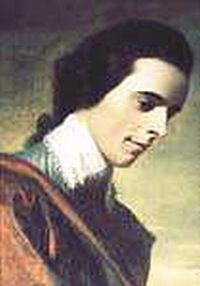Arthur Middleton
Arthur Middleton (June 26, 1742–January 1, 1787), was one of the four signers of the Declaration of Independence from South Carolina.
The son of Henry Middleton, one of South Carolina's representatives in the First Continental Congress and its President in 1774, Arthur also became a political leader in the colony starting in 1764 when he was first elected to the Commons House of Assembly. He succeeded his father as a delegate to the Continental Congress in 1776.
In 1776 he was also part of an 11 man committee that prepared a constitution for the state and was also a co-designer of the state seal. He was chosen Governor of the state in 1778 but declined to take the position.
Early Life
Middleton was born at Middleton Place, St. Andrews Parish, South Carolina. His parents were Henry Middleton and Mary Baker Williams.[1]
He was educated in Britain, at Westminster School, London, and St John's College, Cambridge. He studied law at the Middle Temple and traveled extensively in Europe where his taste in literature, music, and art was developed and refined. In 1764 Arthur and his bride Mary Izard settled at Middleton Place. (His wife was a cousin of South Carolina Congressman Ralph Izard; likewise a son of Congressman Izard was married to a niece of Arthur Middleton, and another son married Arthur's daughter Emma). Keenly interested in Carolina politics, Arthur Middleton was a more radical thinker than his father, Henry Middleton. He was a leader of the American Party in Carolina and one of the boldest members of the Council of Safety and its Secret Committee. In 1776, Arthur was elected to succeed his father in the Continental Congress and subsequently was a signer of the Declaration of Independence. Also in 1776 he and William Henry Drayton designed the Great Seal Of South Carolina. Despite the time he spent in England, his attitude toward Loyalists was said to be ruthless.
During the American Revolutionary War, Arthur served in the defense of Charleston. After the city's fall to the British in 1780, he was sent as a prisoner of war to St. Augustine, Florida (along with Edward Rutledge), until exchanged in July the following year.
Legacy
Arthur died on January 1, 1787 at the age of 44. He was buried in the family tomb in the Gardens at Middleton Place. The plantation then passed to Henry, his eldest son, who went on to a career in politics. He was elected Governor of South Carolina (1810–1812), U.S. Representative (1815–1819), and held the post of Minister to Russia (1820–1830).
The United States Navy ship, USS Arthur Middleton (AP-55/APA-25), was named for him.
He was related to three Confederate Generals:
- A son-in-law Daniel Elliot Huger Jr was an uncle of Confederate General Benjamin Huger.
- A granddaughter of Daniel Elliott Huger Jr (1779–1854) named Mary Procter Huger (1833–1893) was the wife of South Carolina Confederate General Arthur Middleton Manigault (1824–1886) – a grandson of Arthur Middleton's sister, Hester Middleton, and South Carolina Lt. Gov. Charles Drayton. {Note: Charles Drayton was a brother of S.C. Congressman William Henry Drayton.}
- A cousin twice removed, Alica Middleton, was married to Confederate General Roswell S. Ripley. {Note: Alica Middleton's grandmother, Anne Manigault, was a wife of Thomas Middleton – a brother of Arthur Middleton. Anne Manigault was a sister of Joseph Manigault, the father of Confederate General Arthur Middleton Manigault.}
Notes
ReferencesISBN links support NWE through referral fees
External links
- Middleton, Arthur. Bioguide.congress.gov.
- Middleton Place. Middletonplace.org.
- Biography by Rev. Charles A. Goodrich, 1856. Colonialhall.com.
- Biography of the Signers to the Declaration of Independence Books.google.com.
- Dictionary of American Naval Fighting Ships History.navy.mil.
- Arthur Middleton. Findagrave.com.
| |||||||
Credits
New World Encyclopedia writers and editors rewrote and completed the Wikipedia article in accordance with New World Encyclopedia standards. This article abides by terms of the Creative Commons CC-by-sa 3.0 License (CC-by-sa), which may be used and disseminated with proper attribution. Credit is due under the terms of this license that can reference both the New World Encyclopedia contributors and the selfless volunteer contributors of the Wikimedia Foundation. To cite this article click here for a list of acceptable citing formats.The history of earlier contributions by wikipedians is accessible to researchers here:
The history of this article since it was imported to New World Encyclopedia:
Note: Some restrictions may apply to use of individual images which are separately licensed.


